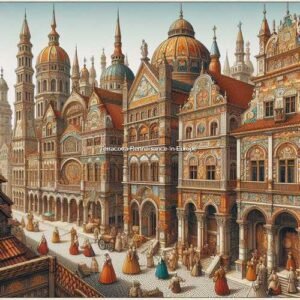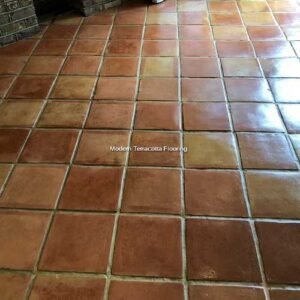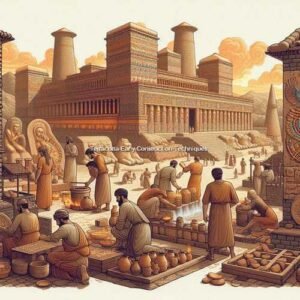Terracotta tiles have a long-standing presence in architecture and design, boasting a fascinating heritage encompassing various cultures and eras. These tiles have proven durable and adapted to changing trends, making them a popular choice for a wide range of uses. In this blog post, we will delve into the intriguing history of Terracotta and explore its widespread applications in modern design.
Ancient Origins: Discovering the Roots of Terracotta Tiles
Origins in Mesopotamia
Terracotta, a material used in construction for centuries, derives its name from the Italian phrase “baked earth.” Its origins can be traced back to the 3rd millennium BC in Mesopotamia, where it was commonly used to construct dwellings and temples. These tiles are perfect for such purposes due to their durability and natural beauty.
In ancient Mesopotamia, Terracotta served a dual purpose—it was not only functional but also carried deep symbolic meaning. The Assyrians and Babylonians extensively used Terracotta to construct palaces and religious sites. Its application served functional and ornamental purposes, highlighting its immense aesthetic and cultural value.
Construction Methods from the Past
The early utilisation of Terracotta in Mesopotamia established the foundation for its lasting impact. Builders in Mesopotamia were well aware of the material's remarkable durability in the face of harsh weather conditions. Creating Terracotta involves shaping clay into desired forms and firing it at high temperatures for a hardened, durable product. This technique has remained virtually the same for millennia.
Evolution in Mediterranean Cultures: The Rise of Terracotta in Greece and Rome
Greece In Antiquity
Terracotta became widely used in the Mediterranean cultures of Greece and Rome, valued for its practicality and pleasing appearance. During ancient times in Greece, Terracotta was a popular material for constructing temples and public buildings. Greek architects excelled in working with Terracotta, creating elaborately shaped tiles arranged in intricate designs.
Advancements in Ancient Rome
The Romans made significant advancements in terracotta tile production techniques. They introduced moulds to ensure uniformity and experimented with various shapes, designs, intricate patterns, and pictorial motifs. Roman builders widely used Terracotta across multiple construction projects, including villas, public baths, and theatres. The development of interlocking roof tiles, known as “tegulae” and “imbrices,” was a remarkable Roman innovation.
Significance in Culture
Terracotta tiles in Roman architecture frequently showcased depictions of mythology and everyday life, reflecting the cultural values and artistic accomplishments of the era. The durability of Terracotta has ensured that many structures have stood the test of time, enabling modern observers to admire the skill of ancient builders.
 Terracotta Renaissance in Europe: Reviving an Ancient Craft
Terracotta Renaissance in Europe: Reviving an Ancient Craft
A New Beginning In The Renaissance
There was a renewed interest in Terracotta during the Renaissance era in Europe. Architects and designers have embraced this versatile material to bring a touch of sophistication to their projects. The tiles beautifully decorated the exteriors of magnificent structures, including grand buildings, churches, and palaces, demonstrating their capacity to elevate visual appeal while offering insulation and safeguarding.
Renowned Renaissance architects, such as Brunelleschi and Michelangelo, skillfully integrated Terracotta into their architectural masterpieces, appreciating its ability to create intricate and captivating exteriors.
Technical and Artistic Advancements
The Renaissance was a time of remarkable technology and art progress. Artisans perfected innovative glazing methods that infused terracotta tiles with rich hues and a lustrous sheen, elevating their allure.
Influence on European Architecture
The extensive use of Terracotta during the Renaissance greatly influenced European architecture, which persisted throughout the Baroque and Rococo eras.
Terracotta in Contemporary Design: Embracing Tradition in Modern Spaces
Modern Applications
Today, Terracotta continues to be popular in contemporary design. Their natural earthy tones and rustic charm lend warmth and character to indoor and outdoor spaces. In modern interior design, terracotta floors create a cosy and inviting atmosphere, often used in kitchens, living rooms, and bathrooms.
Sustainable and Eco-Friendly Choice
Terracotta floors are an eco-friendly option for sustainable building practices. Made from natural clay, they are biodegradable and have a low environmental impact. Their production process requires less energy than other building materials, and their durability means they have a long lifespan, reducing the need for frequent replacements.
Innovative Design Trends
Recent design trends have seen a resurgence in the use of Terracotta, with designers and architects exploring new ways to incorporate this timeless material into their projects. Terracotta tiles easily suit contemporary tastes, from geometric patterns and bold colours to minimalist and industrial aesthetics.
 Common Uses and Applications: Versatile and Functional Terracotta Tiles
Common Uses and Applications: Versatile and Functional Terracotta Tiles
Floor Covering
Terracotta can create captivating feature walls that enhance any room's texture and visual appeal. They are highly effective in spaces that strive for a rustic or Mediterranean-inspired look.
Wall Covering
Terracotta can create stunning feature walls, adding texture and visual interest to any room. They work exceptionally well in spaces aiming for a rustic or Mediterranean-inspired aesthetic.
Roofing Material
Terracotta is a highly durable material, making it excellent for roofing. Terracotta offers exceptional protection from the elements while adding a unique charm to any building.
Stylish Embellishments
Terracotta tiles are famous for decorative accents in various architectural elements, including arches, columns, and cornices. Their adaptability enables designers to craft one-of-a-kind and visually captivating elements.
Landscape And Garden Use
Terracotta tiles are a great choice for enhancing the aesthetic appeal of garden paths, courtyards, and poolside areas. They bring a touch of natural beauty to outdoor spaces, and their earthy tones and textured surfaces effortlessly harmonise with the surrounding natural environment.
FAQs About Terracotta Tiles
What advantages do terracotta tiles offer in sustainable architecture?
Terracotta tiles are crafted with the utmost care, using natural clay, ensuring their eco-friendly nature and minimal environmental impact. With their exceptional durability and impressive lifespan, there is no need for frequent replacements.
What are some ways to improve the colour of terracotta tiles?
Consistent cleaning and effective sealing can help to enhance the colour. Utilising a colour-enhancing sealer can further accentuate the inherent shades.
Are there any current design trends for terracotta tiles?
Indeed, contemporary design incorporates geometric patterns and vibrant colours and seamlessly blends with minimalist and industrial aesthetics.
What are the recommended methods for installing terracotta tiles?
Proper surface preparation, selecting the appropriate adhesive, and allowing ample drying time are crucial for optimal results. Expert installation guarantees a secure and reliable placement.
Is it possible to utilise terracotta tiles for heated flooring systems?
Indeed, terracotta tiles are well-suited for heated flooring systems, ensuring effective heat distribution and a pleasant temperature.
Relevant Hyperlinked Sources
The post: Terracotta Tiles: A Fascinating Journey Through History and Time appeared first on TileCleaningSurrey.co.uk
The Article Terracotta Tiles: An Engaging Exploration of the Past and Present appeared first on https://fabritec.org
The Article Terracotta Tiles: An Engaging Exploration of the Past and Present Was Found On https://limitsofstrategy.com




I find it fascinating how terracotta tiles have transcended their practical applications to become a symbol of cultural identity and artistic expression throughout history. Their journey from ancient Mesopotamia to contemporary design highlights not just the evolution of materials, but also how architecture can tell stories of resilience and beauty.
You’ve hit on something really profound about terracotta tiles. They really do carry so much weight in terms of history and cultural significance. I find it amazing how a simple material can embody so many stories and traditions. For instance, in southern Spain, you see how these tiles are used in the intricate design of patios and courtyards, creating spaces that are not just functional but also vibrant and inviting. There’s a warmth to terracotta that other materials just can’t replicate.
You’ve really captured the essence of what makes terracotta tiles special. They’re more than just materials; they’re vessels of culture and history. In places like southern Spain, every tile seems to tell a story, connecting us to generations past. Think about how they’re made—shaped by hands that have likely followed the same practices for centuries. It’s fascinating to see how their warm hues create a sense of home and community.
You’ve highlighted something truly profound about terracotta tiles. They really do embody not just craftsmanship but also a deep connection to the land and its traditions. Living in a region where old and new coexist, I often find myself drawn to these tiles in places like courtyards or traditional homes. It’s interesting how they can evoke a sense of nostalgia or even make one feel part of a larger story.
You’ve really captured the essence of terracotta tiles beautifully. There’s something so grounding about them, isn’t there? I live in an area where tradition is deeply woven into the fabric of everyday life, and I often find that the simplest things, like those tiles in a courtyard, can heighten our awareness of history.
You’ve hit on something fundamental about terracotta tiles—there’s a tangible quality to them that connects us to the past. It’s interesting how these simple elements in our surroundings can make us pause and appreciate where we come from. In your area, where tradition is interwoven into daily life, I can see how those tiles in a courtyard could serve as a reminder of the stories and experiences that have shaped the community over generations.
You’ve really touched on something profound about terracotta tiles and their connection to history. There’s this quiet strength in them, isn’t there? They carry stories and a sense of place that connects us to generations past. I’ve noticed that the more I pay attention to these little details, the more alive my surroundings feel.
There really is something special about the way terracotta tiles resonate with history. They have this tactile quality that’s hard to ignore, almost like nature’s way of reminding us of our roots. I feel like every scratch and chip tells a story, connecting past and present in a unique dialogue.
You’ve really captured the essence of terracotta tiles with your words. It’s true, they carry a sense of history that’s palpable, almost as if each piece is a little piece of memory from centuries past. The tactile quality you mention plays such a significant role in how we interact with our surroundings. When you walk on them, you can feel the warmth and texture – it’s a physical connection to the earth and to those who came before us.
You’ve really captured a special aspect of terracotta tiles—there’s something undeniably grounding about them. I find it interesting how these materials connect us not just to history, but also to nature. The warmth and texture you describe create a welcoming ambiance in homes, making spaces feel alive and connected to the earth.
You’ve really touched on something profound with your observation about terracotta tiles. There’s indeed a unique connection to the earth when we incorporate natural materials into our homes. I’ve always appreciated how terracotta can evoke a sense of history; it’s almost like walking on a piece of art that has been shaped by time and nature.
It’s interesting how something as seemingly simple as terracotta can carry so much depth. When you mention the connection to the earth, it makes me think about how our choice of materials in our homes can influence our overall well-being. There’s definitely a warmth and grounding quality to natural materials that artificial materials often lack.
You raise an excellent point about the connection between terracotta tiles and both history and nature. These materials truly have a story to tell — each tile is often hand-made and carries the marks of its creation, which adds authenticity to any space.
Thank you for your insightful thoughts! If you’re inspired to bring that warmth and connection to your own space, check out our collection of terracotta tiles that beautifully blend history and nature.
https://arquiaca.org/askadoctor
I completely resonate with what you’re saying about terracotta tiles. They really do seem to carry a piece of history in their texture. It’s fascinating to think about how materials like that hold stories—from the hands that made them to the spaces they’ve inhabited. I sometimes find myself lost in thought when I see aged surfaces; it’s almost like a conversation with the past.
I completely resonate with your thoughts on terracotta tiles. There’s an undeniable warmth to them, isn’t there? The idea that each imperfection carries a story really adds depth to a space. It’s fascinating to think about how materials like terracotta have been used for thousands of years, not just for their beauty but also for their practical properties, like thermal mass and durability.
You’ve captured the essence of terracotta tiles beautifully. There really is something special about how they can transform a space with their warmth and character. Each imperfection does tell a story, and it’s that unique texture that adds so much personality to a room.
You’re right; there’s something uniquely grounding about terracotta tiles. Their rustic charm seems to invite a connection to the earth itself. I can imagine how those tiles in your courtyard serve not just as a surface but as a canvas for stories—perhaps remnants of laughter, adventures, or quiet moments of reflection.
You’ve touched on something truly profound with your comment about terracotta tiles. There’s a certain magic that these tiles bring, don’t you think? When we step into a space adorned with them, we’re not just looking at a floor; we’re standing on layers of history, culture, and craftsmanship.
You’ve captured the essence of terracotta tiles beautifully. They really do carry a whisper of the past, don’t they? It’s fascinating how they can bridge generations and cultures, providing a tangible connection to the craftsmanship that has endured through time.
It’s interesting you mention the craftsmanship behind terracotta tiles. There’s something truly remarkable about materials that embody both function and a rich narrative. That connection to the artisans—hands that blend tradition with creativity—often feels lost in our increasingly automated world.
Your observation touches on a vital aspect of our relationship with everyday objects, like terracotta tiles. When we consider the meticulous work that goes into creating these tiles, we can appreciate their function beyond mere aesthetics. Each piece carries a story, a journey from raw material to a crafted item that adds warmth and depth to our spaces.
You raise a compelling point about the craftsmanship of terracotta tiles and their significance beyond mere aesthetics. It’s true that these materials often carry stories—stories of the artisans, the history of the craft, and even the landscape from which they originate. I find it fascinating how much character a handmade tile can bring to a space, often more than something mass-produced ever could.
You touched on something really interesting about the stories behind terracotta tiles. Each tile carries the essence of its maker, the technique used, and even the land’s influence. It’s wild to think about how a simple tile can reflect a place’s culture and history. I’ve found that when people choose handmade tiles for their homes, they’re not just picking a design; they’re embracing a narrative that can spark conversations and connections. It makes such a difference in creating a space that feels alive and personal. Plus, there’s something incredibly satisfying about knowing your choice supports artisans and keeps those age-old traditions alive. It’s like adding a little piece of the world into your home. What’s your favorite way to incorporate something handmade into your space?
“I’m glad you resonate with that! If you’re interested in exploring some beautifully crafted handmade terracotta tiles that embody these rich stories, check out this link for more inspiration.”
https://arquiaca.org/ChocolateHealth
You bring up such a profound point about handmade tiles and how they carry not just aesthetic value but a deeper connection to culture and history. I often think about how our choices in home decor reflect our values and stories. For me, incorporating handmade elements feels essential for creating a warm, inviting space. A favorite way I’ve done this is by using artisan pottery pieces, not just for their utility but for the stories they tell about their makers and origins.
You’ve hit on something deeply meaningful with the connection between craftsmanship and storytelling in terracotta tiles. It’s fascinating how each tile carries a piece of history, almost like a little snapshot of the artisan’s world. When you walk on a surface made from these tiles, you can almost feel the weight of the hands that shaped them and the stories behind the materials.
You’ve really tapped into something special with your observations about terracotta tiles. It’s fascinating how a simple cube of clay transforms into a canvas for history and culture, isn’t it? In places like southern Spain, as you mentioned, these tiles are more than just flooring; they’re a part of everyday life interwoven with the story of a community. They create that seamless blend between the indoors and outdoors, kind of like a bridge between personal space and the vibrant life outside your door.
You’ve captured the essence of terracotta tiles beautifully. It’s intriguing to think about how something so unassuming can hold so much significance. In southern Spain, as you pointed out, these tiles do indeed serve as a bridge, not just physically but also culturally and emotionally. The way they retain heat in cooler months and keep the space cool in the summer months is also a testament to how well they harmonize with the environment.
I appreciate your thoughts on terracotta tiles; they really do have a quiet yet profound presence, don’t they? It’s fascinating to think about how much history and craftsmanship is embedded in these tiles. Each one seems to tell a story, shaped by the fingers of artisans and the landscape built around it.
I completely agree about terracotta tiles—it’s incredible how they carry so much heritage in their raw beauty. Each tile feels like a piece of the earth, imbued with the cultural narratives of the places they come from. I often find myself thinking about the artisans behind these creations. The craftsmanship isn’t just about the physical tile; it encompasses their skills, traditions, and the stories handed down through generations.
You’ve hit on such a vital aspect of terracotta tiles—the way they intertwine with culture and history. It’s fascinating to think about how each tile is not just a material for flooring or decoration but actually a canvas of stories and emotions. Those artisans who shape each piece pour so much of their lives and traditions into their work. You can almost feel the warmth of their hands and the history of their communities in every tile.
“Absolutely! If you’re inspired by the artistry and heritage of terracotta tiles, you might enjoy exploring some exquisite options that celebrate this rich craftsmanship. Check them out here!”
https://arquiaca.org/ParentAler
It’s interesting how something as simple as terracotta tiles can carry so much weight in both practical and cultural aspects. I have a fondness for how they connect us to the places we live. In southern Spain, it’s almost as if those tiles are storytellers, whispering tales of family gatherings and long summer afternoons. They’re not just inanimate objects; they evoke a sense of history and place, reminding us of the warmth of community.
It’s so true that terracotta tiles embody so much more than mere practicality; they really are a reflection of the culture and history embedded in their design. I’ve always found it interesting how materials like clay, which seem so rustic and elemental, can carry such rich stories, especially in regions with deep historical roots like southern Spain.
It’s interesting how materials like terracotta can evoke such a deep connection to culture and tradition. The way they’re woven into the architecture of southern Spain seems to reflect not just aesthetics but also a way of life. It’s that blend of function and artistry that makes these spaces feel alive. I remember visiting a small town in Andalusia and being struck by how the patios, with their vibrant tiles, became gathering places for families and friends. The stories that those tiles must hold—from celebrations to everyday life—really add to their charm.
You hit the nail on the head with that observation about terracotta and how it shapes the spaces we inhabit. It’s fascinating how something as simple as a tile or a patio can embody generations of history and culture. In southern Spain, particularly in Andalusia, there’s this incredible depth to the materials and designs that really brings the region to life.
It’s interesting how you bring up the journey of terracotta tiles. It’s remarkable to think about how materials like these can carry so much history. They do more than just serve a function; they embody the cultural narratives of the places they come from. I’ve always been struck by how often architecture reflects local resources and the ingenuity of different communities.
You’ve really hit on something special there. Terracotta tiles are like little time capsules, aren’t they? They’ve soaked up sun, rain, and probably some really good stories over the centuries. Imagine if they could talk—what a gossip fest that would be.
You’ve really struck a chord with the idea of terracotta tiles as little time capsules. It’s fascinating to think about all the life that’s unfolded around them; they’re often the silent witnesses to so much history. It makes me wonder what stories they would tell if they could indeed share their gossip.
It’s true—these humble terracotta tiles have a lot of stories to tell. When you think about it, they’re like the world’s oldest Instagram posts, silently showcasing their ‘likes’ from centuries of foot traffic. It’s fascinating how a simple material can have such a rich narrative woven into the fabric of a community’s identity.
I completely agree with you about the richness of materials like terracotta. Each tile has its own story tied to the craftsmanship and the cultural practices of the communities that created them. When you think about it, these materials often reflect the local environment—like the clay sourced from the land or the traditional techniques passed down through generations. It’s fascinating how architecture not only serves functional needs but also acts as a visual narrative, showcasing the culture and history of a place.
I really resonate with what you’re saying about terracotta and how materials like that hold such deep stories. It’s interesting to think about how much the environment influences not just the materials but also the aesthetics of a place. For instance, the way the colors of terracotta can change with the light and seasons makes each structure a living part of its surroundings.
You’ve captured the essence of how materials like terracotta interact with their environments beautifully. The way these materials respond to varying light, shifting seasons, and even the local climate adds an intricate layer to our built surroundings. It goes beyond mere aesthetics; it’s about the dialogue between nature and architecture.
“I’m glad you feel that way! If you’re interested in exploring more about the beauty and versatility of terracotta in architecture and design, check out this inspiring collection.”
https://arquiaca.org/DigestiveHealth
It’s fascinating to hear how much you connect with the essence of terracotta and its relationship with the environment. The way natural materials like this can resonate with their surroundings really adds depth to our understanding of architecture and design. You touched on something essential when you mention how colors can transform with the light and seasons. It’s almost like each building made from terracotta is telling its own story that shifts over time.
“I’m glad you connect with that perspective! If you’re intrigued by the stories that materials tell and how they interact with their environment, you might enjoy exploring more about this in my latest piece.”
https://arquiaca.org/ParentAler
You’ve touched on an interesting aspect of terracotta tiles that often gets overlooked in broader discussions about architecture and design. It’s easy to focus on the raw materials or the aesthetics alone, but when we consider how these tiles have woven themselves through history, it really opens up a dialogue about identity and community.